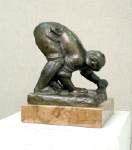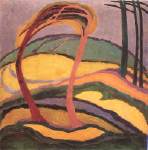

Hungarian art in the first half of the twentieth-century can be classed among two great periods. The first embraces the period of the turn of the century, included the last decade of the 19th and the first two decades of the twenties century, from the millenium years to the end of World War I. The second is the interwar period, the two-and-a-half decades between World War I and II.
The description of the period can be started with the art of Tivadar Csontváry Kosztka. He was a pharmacist at Iglo and started to study. art at the age of 40 at Simon Hollósy in Munich. From the very beginning of his career he was to create a coherent, monumental visionary world. During his study tours to Greece, Tatra, Italy, Lebanon and Palestine he evolved his individual pictorial style of which a representative masterpiece is the monumental painting Ruins of the Greek Theatre in Taormine (1904-07). His fascinating colours and lapping forms on his pictures reflect the influence of Art Nouveau and Post-Impressionism (Self-Portrait, 1896-1902; Madonna Painter, 1898). His Pilgrimage to the Cedars in Lebanon dating from the 1900 years represents his mature symbolism.
At the beginning of the century the revival of the Hungarian painting connected with the prominent artistic movement, the School of Nagybánya. The plan of a collective activity was born in Munich where young painters, gathered round Simon Hollósy, got acquinted with the exciting trends of Naturalism and Realism radiating from France to Europe through literature and visual arts. The artist's colony at Nagybánya was formed at 1896 by Hollósy and his pupils from Munich - aiming to work "...in the open air of Hungary, on the ground of Hungary, being in touch with Hungarian people." According to their aesthetic program they intended to create a painting based on a severe naturalistic conception. One of the most outstanding personalities of Nagybánya group was Károly Ferenczy who created a characteristically individual style in the modern Hungarian painting. His art and teaching influenced almost all the artistic endeavours of the time and through the activity of young artists, the so called Neos he got in touch with avantgardism of the tens and the artists of Post-Nagybánya in the interwar period. The Gardeners (1891) originated from his earlier, naturalistic period. His Munich years are represented by a Self Portrait (1893), with a mature character-analysis, Bird's Song (1893), a paiting of elegiac atmosphere, expressing a symbolic concord of Man and Nature. His Nagybánya period is usually classed among three parts. First his low-keyed biblical pictures, then his "sunny" pictures, his wonderful plein-air paintings: October (1903), Woman Painter (1903), Sunny Morning (1905). In his last period he was impressed by Post-lmpressionism (Archers 1911). Besides Hollósy and Ferenczy, János Thorma, István Réti, Béla Iványi Grünwald and Oszkár Glatz represent the painting of Nagybánya.
At the beginning of the century, simultaneously with the painters of Nagybánya, another artistic trend appeared whose masters with an attitude of social criticism turned back to Mihály Munkácsy and the tradition of Romantic Realism. Adolf Fényes was the member of the Szolnok Artist's Colony, founded in 1902. The paintings from the early low-keyed Day Labourer (1901), (from the Poor Man Series) to the decorative vividness of Poppy-Seed Cake (1910) represent his artistic development.
The term Painters of the Great Plain reflects their attraction to the atmosphere of the region and a continuation of the tradition of Hungarian Realism. The expressive style characterizes the group's feature was enriched by individual pictorial expressions determined by several artistic temperaments. Among the painters of the group - mostly connected with Hódmezővásárhely - János Tornyai was the dramatic, Gyula Rudnay the romantic and József Koszta was the one who got to the root of an intuitive, expressionist painting with his intensive colours and passionate gestures at the second half of the tens. The oeuvres of the above mentioned artists were not discontinued in the interwar period, in the case of Rudnay and Koszta until after 1945.
Through his staggering portrayal of poverty, reprobation and the horrors of war the ceuvre of László Mednyánszky can be brought into connection with Munkácsy's inheritance but his landscapes stand closer to the tradition of French Naturalism. His art is represented by a rich collection of his dramatic figural compositions, vagabond pictures, war pictures and expressive landscapes.
In Hungary, similarly to Europe, the significant inventions were carried out in painting. The prominent masters of sculpture created academic, neoclassic and impressionist sculptures. Ferenc Medgyessy was one of the very first masters who, breaking with a traditional way of plastic formation, typical of the period, went back to the origin, the Egyptian and classical art and with his monumental peasant figures reformed the Hungarian plastic art. Some of his early masterpieces: Fat Thinker (1911 ), Scrubbíng Woman (1913), Small Equestrian Statue (1915), Mother and Child (1917), Lengyel Funeral Monument (1917).
Post-Impressionism, a complex artistic trend in Hungary at the turn of the century, refers to the considerable style of European art originated in Impressionism. Hungarian Post-Impressionism does not mean an integral whole, but rather a colourful mixture of several individual styles of prominent masters. Besides Csontváry's the works of Lajos Gulácsy, János Vaszary, József Rippl-Rónai and Fülöp Ö. Beck, the sculptor belong to this trend.
Similarly to Csontváry the oeuvre of Gulácsy cannot be classed among any "-isms" of the period. He was inspired by the Italian Renaissance and the l9th century British pre-Raphaelite movement. All his works, inspired by his imaginative fantasy, reflect a strange dreamworld. Hungarian surrealist painters respected him as their spiritual ancestor (Self Portrait Wearing a Hat, 1908; Chevalier Aux Roses, 1917-18). Vaszary's Golden Age (1898) and a tapestry from Gödöllő workshop (Honey-Cake Vendor, 1905) represent his early phase greatly influenced by Art Nouveau and illustrate an attraction to folk art, as well.
József Rippl-Rónai is an important representative of Hungarian Post-Impressionism. At the end of the l9th century he worked with the Nabis in France as a well-respected member of it. His well-known masterpieces represent the different stages of his artistic development: Woman with Bird Cage (1892) from his Paris years, Christmas (1903), My Father and Uncle Piacsek Drinking Red Wine (1907) from his Kaposvár period and some pastels of his old age like Self Portrait with Red Beret (1924). Although the Hungarian visual arts were greatly impressed by Art Nouveau at the turn of the century only the above mentioned masters made its essence and stylistic consequences really their own. The Artist's Colony at Gödöllő, founded at the beginning of the century, was a well-organized "workshop" of Hungarian Art Nouveau. The members of the group worked out a complex philosophical and aesthetic system adapting their ideas to our social conditions. The works of Aladár Kőrösfői-Kriesch and Sándor Nagy show the many-sided activity of Gödöllő-group at the exhibition.
János Nagy Balogh, the solitary painter, worked alone and his puritan works never occured at any public exhibitions during his lifetime. His genre-paintings of poor environment, his navvy pictures and self-portraits reflect a geometrically structured expression foreshadowing a constructivist tendency realized in the art of Activists. The young József Egry, taking the hint of the contemporary social movements, painted poor people and dockers using a similar form of expression as the above mentioned Nagy Balogh.
A group of young artists, the so called Neos who denied the severe naturalism of Nagybánya Artist's Colony carried the germs of Hungarian avantgarde. Béla Czóbel, Lajos Tihanyi, Sándor Ziffer, Vilmos Perlrott-Csaba and Béla Iványi Grünwald, Károly Kernstok, among the elders, by the influence of the French masters of Post-Impressionism, above all of Cézanne and Matisse, abandoned the impressionist method of painting and led on to the art of the first avantgarde group of artists The Eight, founded in 1909. Róbert Berény, Dezső Czigány, Béla Czóbel, Károly Kernstok, Ödön Márffy, Dezső Orbán, Bertalan Pór, Lajos Tihanyi, the painters and Márk Vedres, Vilmos Fémes Beck, the sculptors were the members of the group.
Their work originated in the radical intellectual movements of the early tens and was equivalent to the revolution of literature and music hall-marked with the names of Endre Ady and Béla Bartók. In spite of common aims and collective activity The Eight's style was quite complex. A rational principled composition of Cézanne and the cubists, the decorativity of Fauves and the influence of German Expressionism lived side by side. Their many-sided artistic activities are represented by the monumental picture of Kernstok Riders on the Shore (1910) and a the tableau of Bertalan Pór Family (1909).
The revolutionary change beginning with The Eight in the early tens culminated at the end of the war. A radical movement of visual arts and literature, known as Activism, was gradually forming around the journal "Tett" (Action) and later on "Ma" (Today) edited by Lajos Kassák. The Activists went farther by developing the cubist and expressionist initiations of The Eight into a more radical direction. Two prominent masters of Activism were József Nemes Lampérth and Béla Uitz, beside Lajos Tihanyi, János Kmetty, Vilmos Perlrott-Csaba, Sándor Galimberti, Ede Bohacsek, János Mattis Teutsch, Sándor Bortnyik and Lajos Kassák. The sculptures of Pál Pátzay, Ferenc Spranger, Sándor Gergely were characterized by expressive formation. Béni Ferenczy's Standing Boy reflects the influence of Cubism.
Kassák painted his two-dimensional constructive compositions, known as picture architecture in the twenties. Uitz made similar experiments with his series Art-Analysis. Bortnyik, just back from Weimar, went on this way to his metaphisical-surrealist period. The period from the painters of Nagybánya to the Activism ends with their works.